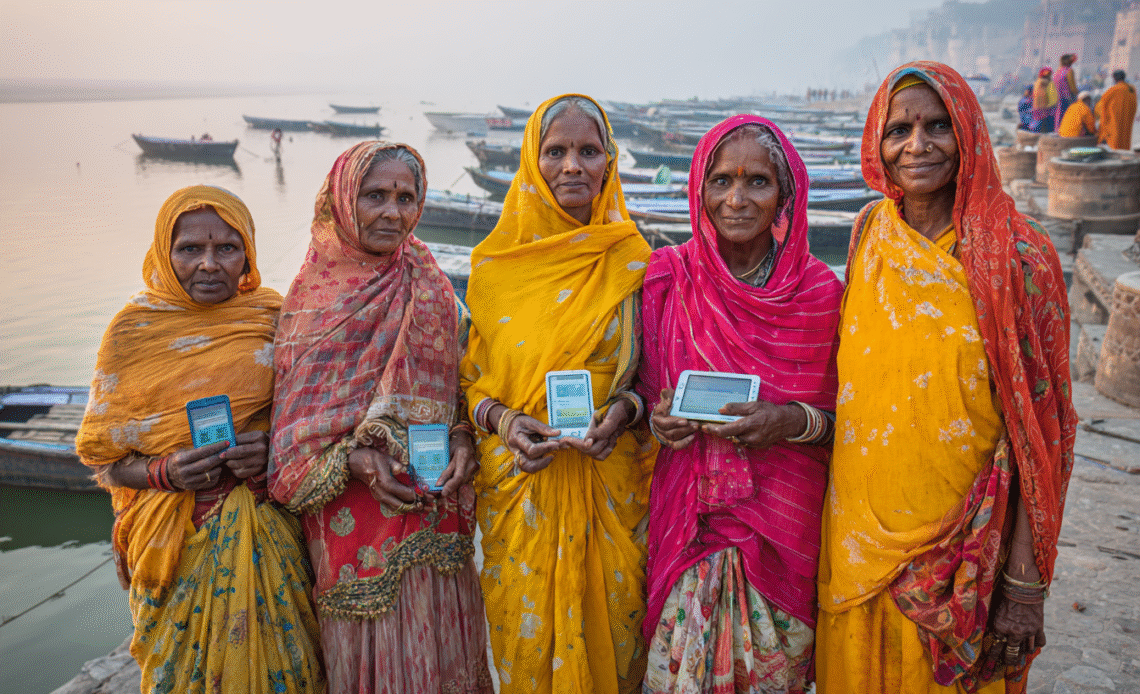
On the ghats of the Ganga, a quiet transformation is underway. Far from India’s bustling startup hubs of Bengaluru, Gurugram, or Mumbai, rural women in Uttar Pradesh are scripting their own entrepreneurial story under the banner of “Digital Nari.”
Launched jointly by PayNearby, the Uttar Pradesh State Rural Livelihood Mission (UPSRLM), and the Varanasi Commissioner’s Office, the campaign aims to empower women by combining digital financial services, skill training, and grassroots entrepreneurship. Within months, it has already touched the lives of 10,000 women across Varanasi district, with ambitious plans to scale to 100,000 women across multiple states in the coming years.
Breaking Barriers Through Digital Sakhi Networks
The program identifies and trains women as Vidyut Sakhi (focused on electricity and utility services) and BC Sakhi (Banking Correspondent Sakhi). These women act as last-mile service providers, bringing essential digital and financial services to their communities.
In practical terms, this means a villager no longer needs to travel several kilometers for a bank withdrawal, insurance premium payment, or utility bill settlement. Instead, the neighborhood Sakhi can process these transactions in real time using digital devices, biometric authentication, and PayNearby’s tech platform.
For many rural households, this is their first direct experience with formal finance and digital commerce — delivered not by distant institutions, but by women from within their own communities.
Empowerment Beyond Economics
While the initiative is creating new income streams, its impact goes deeper than financials. Rural women who once hesitated to step out of their homes are now trusted service providers, interacting daily with neighbors, officials, and local businesses.
The sense of empowerment is palpable. Sunita Devi, a 32-year-old BC Sakhi from Chiraigaon block, says she never imagined being called a “banker” in her village. “Earlier, even to deposit ₹500 we had to take a bus to the town. Now people come to my house, and I help them with banking. I earn an income, but more importantly, my daughters see me as someone respected.”
This social recognition is as transformative as the additional income of ₹3,000–₹8,000 per month many Sakhis now earn.
Tackling Rural India’s Digital Divide
Digital Nari is designed to solve multiple structural challenges:
- Financial Inclusion: Nearly 190 million Indians remain unbanked, with women disproportionately excluded. By training Sakhis, the initiative addresses both accessibility and trust barriers.
- Digital Literacy: The campaign doubles as a digital education drive. Villagers learn not only to transact digitally but also to adopt online tools for e-commerce, healthcare, and government schemes.
- Employment Creation: With agriculture under stress and rural job opportunities scarce, the program creates micro-entrepreneurs who are self-sustaining.
- Gender Gap: Only 14% of Indian entrepreneurs are women. Digital Nari directly challenges this by nurturing a pipeline of rural women entrepreneurs, many of whom are first-time earners.
Public–Private Partnerships as Catalysts
- The campaign exemplifies how public–private partnerships (PPP) can accelerate rural innovation.
- UPSRLM brings grassroots mobilization and credibility through its Self-Help Group (SHG) networks.
- PayNearby provides the technology backbone, digital tools, and financial service integration.
- Local administration ensures smooth rollout and community engagement.
- This triangulation ensures that the initiative is sustainable and scalable, rather than a one-off pilot.
According to PayNearby CEO Anand Kumar Bajaj, “Financial inclusion cannot happen in air-conditioned offices. It has to reach the last mile, and who better than rural women to carry this torch? Digital Nari is not charity; it is about building a rural digital economy powered by women.”
Scaling Ambitions: 100,000 Women by 2027
With early success in Varanasi, plans are underway to expand Digital Nari across Uttar Pradesh and eventually to other states like Bihar, Jharkhand, and Madhya Pradesh. The target is to train and empower 100,000 women by 2027, creating a ripple effect of inclusion across 50,000 villages.
The model is replicable: the Sakhi network acts as a distribution channel for financial services, digital literacy, and even e-commerce. Experts believe that once critical mass is achieved, Sakhis could also facilitate telemedicine consultations, agri-advisory services, and digital government benefits, making them hubs of rural digital life.
Challenges on the Road Ahead
The journey, however, is not without obstacles:
- Cultural Barriers: In many villages, patriarchal norms still restrict women’s mobility and decision-making power. Some Sakhis face resistance at home or skepticism in their communities.
- Digital Infrastructure: Patchy internet connectivity and unreliable electricity continue to hamper seamless service delivery.
- Sustainability of Income: To keep Sakhis motivated, transaction volumes must be high enough to ensure steady earnings. Scaling beyond initial enthusiasm will require sustained demand.
- Policy experts argue that continuous training, community sensitization, and infrastructure upgrades will be critical for the program’s long-term success.
A New Template for Rural Entrepreneurship
Despite challenges, Digital Nari is emerging as a template for inclusive entrepreneurship. It bridges the gender gap, accelerates financial inclusion, and leverages technology to solve deep-rooted problems of access.
For India, which aims to become a $5 trillion economy with $1 trillion from the digital sector, initiatives like this are essential. They demonstrate that the next wave of digital growth will not come only from metros or startups backed by global VCs — but from women in villages who are becoming bankers, entrepreneurs, and digital leaders.
Conclusion
As the sun sets over Varanasi’s ghats, women like Sunita Devi count the day’s transactions — small amounts, often ₹200 or ₹500, but each one a building block of trust and empowerment.
Digital Nari is not just about financial services. It is about rewriting the role of rural women in India’s growth story. It is about moving from dependency to dignity, from consumers to creators, and from the margins to the mainstream.
And if its ambitious scaling succeeds, India may witness a quiet revolution — where one lakh rural women entrepreneurs light the path to a more inclusive digital economy.

